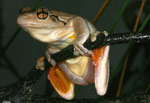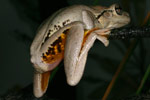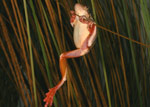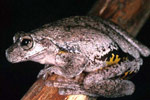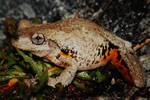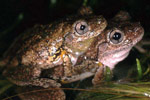Litoria peroni
Peron's Tree Frog
Also: Emerald-spotted Tree Frog, Laughing Tree Frog, Maniacal Cackle Frog

+ 49 kb Peron's Tree Frog (Litoria peroni)
Sometimes known as the Maniacal Cackle Frog due to its distinctive call. A large and agile climber, widespread throughout the Murray-Darling basin, but only locally common.
Distribution and habitat

Adults frequent wet and dry forest, woodlands, shrublands, and open areas; often long distances from the water where they spawn during breeding season. Eggs and tadpoles are found in still water in swamps, dams, streamside ponds, and lagoons.
There is a detailed distribution map available for: Victoria.
Calling
Males call from near water either on the ground or in vegetation. The call is very long and drawn out, slowly pulsed and increasing in loudness - "cra-ah-ah-ah-ah-ah-ah-ah-ahhk".
Copyright Murray Littlejohn. Recorded by Murray Littlejohn. Must not be reproduced without permission.
Life cycle
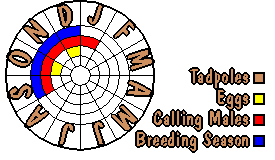
Distinguishing characteristics

+ 43 kb Litoria peroni's pupil appears to be cross-shaped.
Adult
length: 45-70mm.
The eggs are pigmented in jelly. The tadpoles are pale golden-yellow to iridescent green. Adults have bright yellow with black mottling on armpits, groin, and backs of thighs. They have a cross-shaped pupil and small (sometimes indistinct) emerald green flecks on the back.
Visible features
Presented here is the information stored in the frogs.org.au database which is used to identify frogs based on their appearance. It is intended to be used in a key guide for separating species so some of the information (for example, back colours) may be rather non-specific. The system is currently being developed - if you notice errors in the data, please write to Dave Black at the address at the bottom of the page.
Important note: This information details only the appearance of the frog. If an "or" appears in the description, this may mean either that there is some variation within the species or that the feature might be observed differently by different people. For example, if a frog has very small toe pads, it may be listed as having "Toe pads: present or absent".
Size
Up to between 30mm and 60mm
Eyes, hands, and feet
Pupils: cross-shaped
Toe pads: present
Webbing on feet: half-webbing
Belly
Texture: smooth
Pattern: plain
Colour: single colour
Back
Texture: rough
Pattern: plain or spotted
Colour: single colour or multi-coloured
Glands and tubercles
Parotoid gland: absent
Tibial gland: absent
Metatarsal tubercles: Non-keratinised glands present (fleshy or uncoloured) or absent
Similar species (note: this version was written for Victorian species).
Peron's Tree Frog is distinguished from all other Victorian frogs by its cross-shaped pupil.
Litoria peroni image gallery
Breeding activity
The scientific names of Litoria peroni
Alternate spelling: Litoria peronii
- Hyla nebulosa (Peron 1807)
- Dendrohyas peronii (Tschudi 1838)
- ?[Hyla latopalmata watjulumensis] [part] (Copland 1957)
- Litoria peroni (Tschudi 1838)


